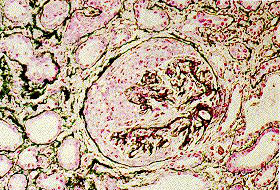Resumo
Definição
History and exam
Key diagnostic factors
- hematuria
- edema
- hypertension
Other diagnostic factors
- oliguria
- anorexia
- nausea
- malaise
- weight loss
- fever
- skin rash
- arthralgia
- hemoptysis
- abdominal pain
- sore throat
- hypervolemia
Risk factors
- group A beta-hemolytic Streptococcus
- respiratory infections
- gastrointestinal infections
- hepatitis B
- hepatitis C
- infective endocarditis
- HIV
- systemic lupus erythematosus (SLE)
- systemic vasculitis
- lung cancer
- colorectal cancer
- Hodgkin lymphoma
- non-Hodgkin lymphoma
- leukemia
- thymoma
- hemolytic uremic syndrome
- drugs
Diagnostic tests
1st tests to order
- urinalysis and microscopy of urine sediment
- comprehensive metabolic profile
- estimated glomerular filtration rate (eGFR)
- complete blood count
- lipid profile
- 24-hour urine collection
- ultrasound of kidneys
Tests to consider
- spot urine protein:creatinine ratio (PCR)
- spot urine albumin:creatinine ratio (ACR)
- erythrocyte sedimentation rate (ESR) or C-reactive protein (CRP)
- complement levels
- rheumatoid factor
- antineutrophil cytoplasmic antibody
- antiglomerular basement membrane (GBM) antibody
- antistreptolysin O antibody
- antihyaluronidase
- anti-DNase
- anti-double-stranded DNA
- antinuclear antibody
- cryoglobulins
- hepatitis C virus and hepatitis B virus serology
- HIV serology
- serum or urine protein electrophoresis
- serum free light chains
- drug screen
- kidney biopsy
- antiphospholipase A2 receptor antibodies
- computed tomographic scan of chest and abdomen
Treatment algorithm
mild disease
moderate-severe disease
rapidly progressive
Contributors
Authors
Nabeel Aslam, MD, FASN
Associate Professor of Medicine
Consultant Nephrologist
Mayo Clinic
Jacksonville
FL
Disclosures
NA declares that he has served on advisory boards for Travere Therapeutics and Chinook Therapeutics. He has received research grants from Idorsia, Novartis, and Baxter.
Acknowledgements
Dr Nabeel Aslam would like to gratefully acknowledge Dr Jeremy Levy, Dr Padmanabhan Premkumar, Dr Priyanka Sharma, and Dr Ajay Kumar, previous contributors to this topic.
Disclosures
JL, PP, PS, and AK declare that they have no competing interests.
Peer reviewers
Martin Schreiber, MD
Department Chairman
Nephrology and Hypertension
Cleveland Clinic Foundation
Cleveland
OH
Disclosures
MS declares that he has no competing interests.
Patrick Naish, MB, FRCP
Teaching Fellow
Keele University Medical School
Keele
UK
Disclosures
PN declares that he has no competing interests.
Richard Banks, MBBS, FRCP, MD
Consultant Nephrologist
Gloucestershire Royal Hospital
Gloucester
UK
Disclosures
RB declares that he has no competing interests.
Mark Thomas, BSc, MBBS, MD, FRCP
Consultant Nephrologist
University Hospitals Birmingham
Birmingham
UK
Disclosures
MT declares that he has no competing interests.
Peer reviewer acknowledgements
BMJ Best Practice topics are updated on a rolling basis in line with developments in evidence and guidance. The peer reviewers listed here have reviewed the content at least once during the history of the topic.
Disclosures
Peer reviewer affiliations and disclosures pertain to the time of the review.
References
Key articles
Kidney Disease: Improving Global Outcomes (KDIGO) Glomerular Diseases Work Group. KDIGO 2021 Clinical practice guideline for the management of glomerular diseases. Kidney Int. 2021 Oct;100(4s):S1-276.Full text Abstract
Sethi S, De Vriese AS, Fervenza FC. Acute glomerulonephritis. Lancet. 2022 Apr 23;399(10335):1646-63. Abstract
Walters GD, Willis NS, Cooper TE, et al. Interventions for renal vasculitis in adults. Cochrane Database Syst Rev. 2020 Jan 13;(1):CD003232.Full text Abstract
Reference articles
A full list of sources referenced in this topic is available to users with access to all of BMJ Best Practice.

Differentials
- Nephrolithiasis
- Bladder cancer
- Renal cancer
More DifferentialsGuidelines
- KDIGO clinical practice guideline for antineutrophilic cytoplasmic antibody (ANCA)-associated vasculitis
- KDIGO clinical practice guideline for the management of lupus nephritis
More GuidelinesPatient information
Glomerulonephritis
Kidney infection
More Patient informationCalculators
Glomerular Filtration Rate Estimate by CKD-EPI Equation
More CalculatorsLog in or subscribe to access all of BMJ Best Practice
Use of this content is subject to our disclaimer